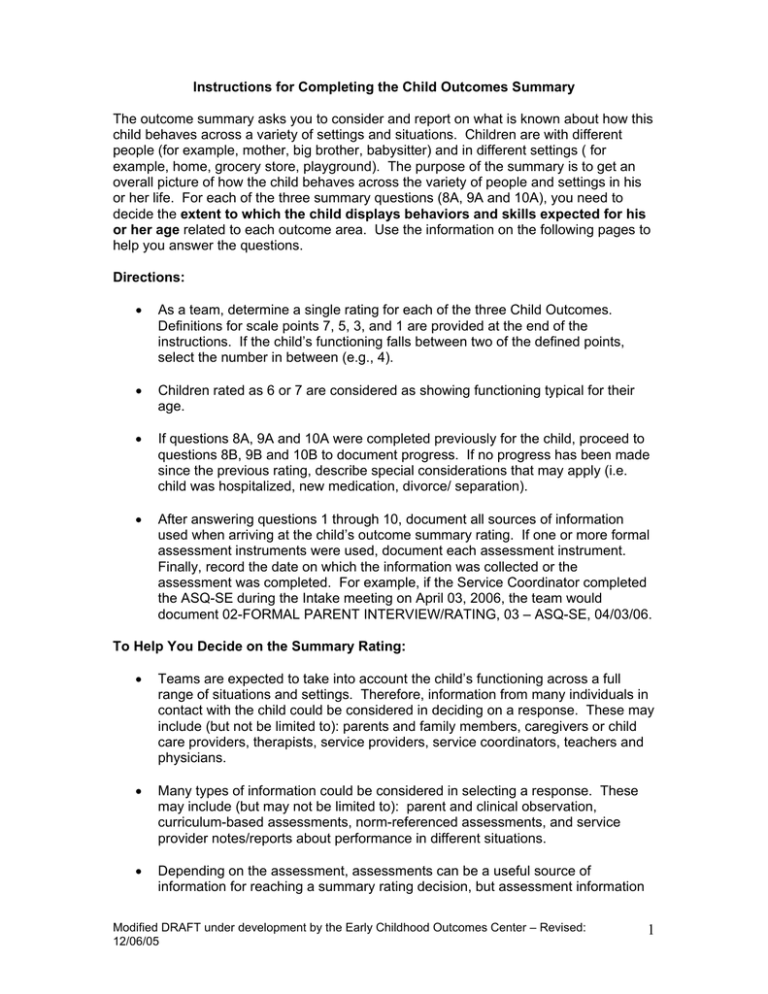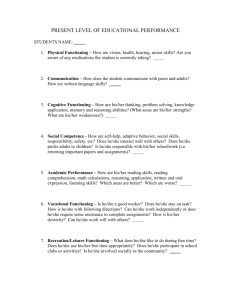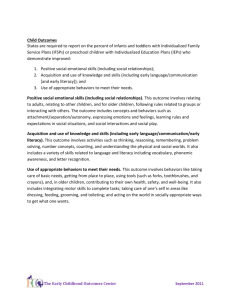Instructions for Completing the Child Outcomes Summary
advertisement

Instructions for Completing the Child Outcomes Summary The outcome summary asks you to consider and report on what is known about how this child behaves across a variety of settings and situations. Children are with different people (for example, mother, big brother, babysitter) and in different settings ( for example, home, grocery store, playground). The purpose of the summary is to get an overall picture of how the child behaves across the variety of people and settings in his or her life. For each of the three summary questions (8A, 9A and 10A), you need to decide the extent to which the child displays behaviors and skills expected for his or her age related to each outcome area. Use the information on the following pages to help you answer the questions. Directions: • As a team, determine a single rating for each of the three Child Outcomes. Definitions for scale points 7, 5, 3, and 1 are provided at the end of the instructions. If the child’s functioning falls between two of the defined points, select the number in between (e.g., 4). • Children rated as 6 or 7 are considered as showing functioning typical for their age. • If questions 8A, 9A and 10A were completed previously for the child, proceed to questions 8B, 9B and 10B to document progress. If no progress has been made since the previous rating, describe special considerations that may apply (i.e. child was hospitalized, new medication, divorce/ separation). • After answering questions 1 through 10, document all sources of information used when arriving at the child’s outcome summary rating. If one or more formal assessment instruments were used, document each assessment instrument. Finally, record the date on which the information was collected or the assessment was completed. For example, if the Service Coordinator completed the ASQ-SE during the Intake meeting on April 03, 2006, the team would document 02-FORMAL PARENT INTERVIEW/RATING, 03 – ASQ-SE, 04/03/06. To Help You Decide on the Summary Rating: • Teams are expected to take into account the child’s functioning across a full range of situations and settings. Therefore, information from many individuals in contact with the child could be considered in deciding on a response. These may include (but not be limited to): parents and family members, caregivers or child care providers, therapists, service providers, service coordinators, teachers and physicians. • Many types of information could be considered in selecting a response. These may include (but may not be limited to): parent and clinical observation, curriculum-based assessments, norm-referenced assessments, and service provider notes/reports about performance in different situations. • Depending on the assessment, assessments can be a useful source of information for reaching a summary rating decision, but assessment information Modified DRAFT under development by the Early Childhood Outcomes Center – Revised: 12/06/05 1 should be placed in context with other information available about a child. Many assessments are domain-based and were not designed to provide information about functional behaviors and functioning across a variety of situations. Knowing that a child has or has not mastered assessment items that are related to the outcome provides helpful information, but the information should be used in conjunction with what else is known about the child. A high score on a set of items in a domain related to the outcome might not mean the child has achieved the outcome and, conversely, a low score might not mean the child has not achieved it. • Responses should reflect the child’s current functioning across the typical settings and situations that make up his/her day. Responses should convey the child’s typical functioning across typical settings, not his/her capacity to function under ideal circumstances. • If assistive technology or special accommodations are available in the child’s everyday environments, then the response should describe the child’s functioning using those adaptations. However, if technology is only available in some environments or is not available for the child, rate the child’s functioning with whatever assistance is commonly present. Responses are to reflect the child’s actual functioning across a range of settings, not his/her capacity to function under ideal circumstances. Additional Information The outcomes reflect several beliefs about young children: • It is important that all children be successful participants in a variety of settings both now and in the future. Achieving the outcomes is key to being successful participants. • Programs for young children and their families are working to ensure that all children will have the best possible chance of succeeding in kindergarten and later in school – even though school might be several years off for some children. Children who have achieved the outcomes prior to kindergarten entry have a high probability of being successful in kindergarten. • Learning and development occur continuously in the years preceding kindergarten. There is much variation in how children develop but children whose development is consistently below what is expected for their age are at risk of not being successful in kindergarten and later school years. • For many children, the Summary questions will be answered more than once. The hope is that, with time, many children will show good progress and achieve a higher rating. The goal of high quality early childhood services is to help children develop and learn to the best of their abilities. For many children, good services will help them get a higher response in the future. Note: The outcomes summary was not designed to determine eligibility for services. It would be inappropriate to use it in this way. Modified DRAFT under development by the Early Childhood Outcomes Center – Revised: 12/06/05 2 Definitions for Outcome Ratings Completely means: 7 6 Somewhat means: 5 4 Emerging means: 3 2 Not Yet means: 1 Child shows behaviors and skills expected for his or her age in all or almost all everyday situations that are part of the child’s life. • Behavior and skills are considered typical for his or her age. • No one has any concerns about the child’s functioning in this outcome area. Between Completely and Somewhat • Child’s functioning generally is considered typical for his or her age but there are some concerns about the child’s functioning. Child shows behavior and skills expected for his or her age some of the time across situations. • Behavior and skills are a mix of age appropriate and not appropriate. • Behavior and skills might be described as more like those of a slightly younger child. • Some behaviors or conditions might be interfering with the child’s capability to achieve age-expected behavior and skills. Between Somewhat and Emerging Child does not yet show behaviors and skills expected of a child of his or her age in any situation. Child’s behaviors and skills include immediate foundational skills upon which to build age expected skills. • Behaviors and skills might be described as more like those of a younger child. • Some behaviors or conditions might be interfering with the child’s capability to achieve age-expected behavior and skills. Between Emerging and Not Yet Child does not yet show behaviors and skills expected of a child his or her age in any situation. Child’s skills and behaviors also do not yet include any immediate foundational skills upon which to build age expected skills. • Child’s ways of forming and maintaining social relationships might be described as more like those of a much younger child. • Some behaviors or conditions might be seriously interfering with the child’s capability to achieve ageexpected behaviors and skills. Modified DRAFT under development by the Early Childhood Outcomes Center – Revised: 12/06/05 3


